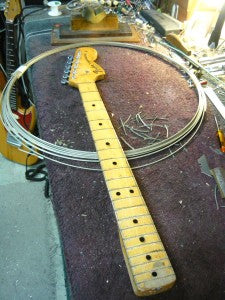1971 Strat refret
Share
I have done many, many refrets over the years and on top of the hundreds I've done on old necks I've fretted about 150 new necks that I've made also and one thing about refrets is ............ they're nearly all different in some small way. That's what I love about guitar repairs. You can do the same job over and over again, and there's always something new.
This was a particularly interesting one. I had never seen such a worn fret in my life. They were so low I couldn't get enough hold with my pincers to remove them.
This joined with the fact that Fender packed on the finish so thick on this era neck the frets were literally down to the paint.
Being an old Fender neck and the fact that it feels GREAT, it was worth the extra effort.
I ended up having to remove the frets from the side. Just "picking" up the end of the fret and once clear of the board and paint, I could get my pincers on it to pull it out.
I always use heat when removing frets. Not all frets are glued in but after years of sitting in one place a little heat can do wonders.
The customer wanted the neck to look old but with new usable frets so with all the frets out it was just a matter of sanding the board flat while keeping as much of the original finish and "mojo" as possible.
The slots were cleaned out and readied for new frets. They were full of gunk (oil, sweat and skin) from years of playing.
The frets are cut to length and fitted into each slot. This neck had worn slots and the big tang frets were still a little "loose" for my liking so these frets were glued back in to help. These are standard size "Fender" frets but the customer can choose any size fret they like at this stage.
With the new frets in and ends cut and dressed the neck is starting to come together. Dressing the ends and making the end angle right is crucial to the way the neck will feel and play and I've seen quite a few refrets that are ruined by this point.
With thin necks like this I make the angle a "little" steeper and round the edges slightly to give a little extra width on the fret.
It's hard to tell from the pics but this is pretty much the finished neck. The frets are dressed and crowned and then polished to a mirror finish. The fretboard is polished in the process but we still have all the grime and wear so once it's been played for a couple of months it will look old again.
I don't recommend refrets lightly. I've actually talked more people out of refrets than I've done. The best refret can change the tone and playability of a guitar. If a repairer tells you differently, take it somewhere else. I don't feel a need to charge people for a job that doesn't need to be done and might change their pride a joy.
A common thing with refrets is if you go from very small frets to big frets sometimes customers say "my guitar doesn't intonate very well any more" This is not a fault of the guitar (or repairer) as the frets go back in EXACTLY the same place they came out of. It's actually that you need to change your playing style. If you squeeze hard on small frets the string sharpens marginally.If you squeeze hard on big frets the string can sharpen considerably as the string has further to go to touch the fretboard.
Like with ANY repair I do. If you're not happy, or have questions, come back and talk about it. It might be my fault, it might be yours, it might be the guitar but you won't know unless you come back and talk.
This neck is ready to go back onto the guitar so I'll do a story about that as it's a "bitsa" Strat and needs some parts fitted that might interest some people.












